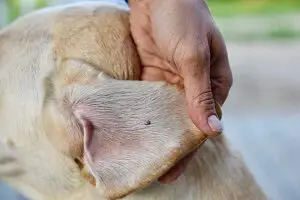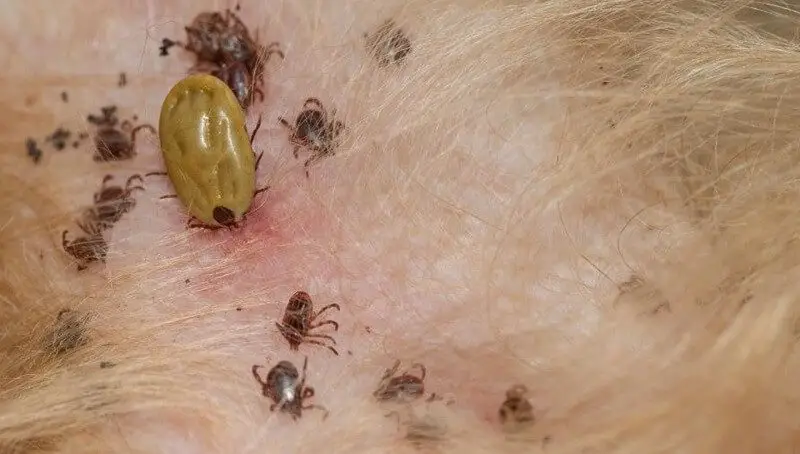Infestation of seed ticks in your dog can lead to severe consequences so immediate treatment is a must. This will mostly occur in spring and if identified in time, will usually lead to no long-lasting effects.
But what exactly are ticks?
TIcks are a kind of parasite called ectoparasites, that will need a host organism to feed on. They will consume the blood of their host. Out of all the tick species, only two will actually infect the dogs. These are the brown dog tick and the American dog tick. These ticks aren’t necessarily a threat on their own, as they won’t produce a lot of pain. Their main threat comes from the fact that they are vectors that are able to transmit many violent and sometimes lethal diseases like rocky mountain fever, Lyme disease, canine jaundice, and more. The larval stage of a tick is called a seed tick, but some people will sometimes call smaller ticks seed ticks. Their name comes from the fact that they look just like seeds, being the size of a pinhead.
You might also like my articles on why a dog would not eat but drink water, whether dogs can eat spicy food, and whether you should beat your dog.
You will usually find seed ticks in outdoor places full of vegetation like shrubs or lawn grass. They will first crawl on the animal after an initial contact, and then attach themselves to the animal with their strong mandibles and feeding tube (hypostome). The initial infestation isn’t always harmful. It will usually depend on the number of ticks that are feeding at the same time on the host and the duration of their feeding. Even if they don’t carry any ugly diseases, if they aren’t removed for a long time, they can cause symptoms like weight loss, loss of appetite, fever, lethargy, and runny nose. A combination of these symptoms caused by ticks is called tick-borne disease.
You will notice these bugs as being very small in size, similar to poppy seeds, with slight brown color and three pairs of legs. As they continue to suck blood from their host, they will usually turn bluish. There are some species of ticks that will detach themselves from the animal after they had enough to eat, which is usually 3 to 6 days after infestation, while others might spend their whole life on an animal.
Considering that your dog is most likely to get infested during the spring months, there are certain precautions you should really consider during this period to protect the pet from these tiny vampire-like parasites.
How Do You Get Rid of Seed Ticks?
You will usually have a hard time noticing seed ticks until they grow enough or are in a larger number. You will have to keep an eye on your pet, especially during spring, when this type of infestation is more likely to occur. During this period, you will have to inspect your pet’s skin, with particular emphasis on feet, ears, and neck.
Manual Removal
 When you identify these parasites, especially if they are in small numbers, you can try to remove them one by one from the dog’s skin using pointed tweezers. When it comes to younger ticks, these don’t have the strength to cling strongly to the pet’s skin, making their manual removal pretty easy compared to removing adult ones.
When you identify these parasites, especially if they are in small numbers, you can try to remove them one by one from the dog’s skin using pointed tweezers. When it comes to younger ticks, these don’t have the strength to cling strongly to the pet’s skin, making their manual removal pretty easy compared to removing adult ones.
Shampoo Your Dog
When these ticks are in considerable numbers, it will become pretty hard to remove them one by one with a tweezer. This is when you could try to use an over-the-counter tick shampoo to bathe your dog completely. If you’re afraid that your dog will still have some tick larvae or eggs on it after an initial bath, you can use the shampoo to clean your dog for a few consecutive days.
Clean Dog Bedding
Even if you got rid of all the ticks from your dog’s fur, some of these pesky parasites might still be present in the pet’s surroundings. So, if you want to make sure you completely remove these parasites from around your dog, you should vacuum the carpet and properly clean all of the areas where the dog plays and sleeps.
Spray Insecticides
You can also use some decent insecticide to stop these ticks from breeding in infected areas. Always make sure you read the contraindications of the insecticide and follow the instructions while spraying, to make sure you won’t endanger your and your pet’s health.
Keep in mind that removing these pests from your pet’s surroundings is a must and should be done as soon as possible. Even though they will be harmless most of the time, they can still carry some powerful diseases that could put your dog’s life in danger.
If you do all of the above but still find it hard to get rid of the tick infestation on your dog, you should go to a veterinarian for additional tests and tips. Severe infestations also come with signs of itching and scratching.




